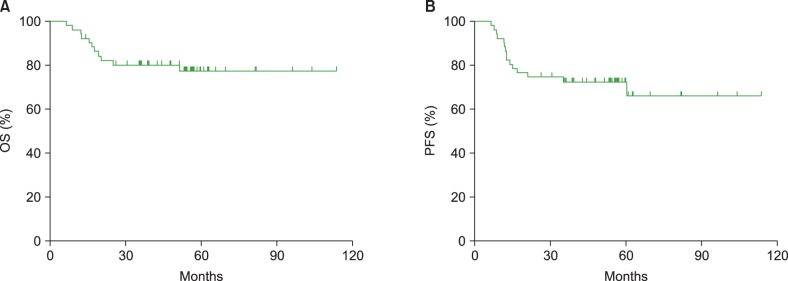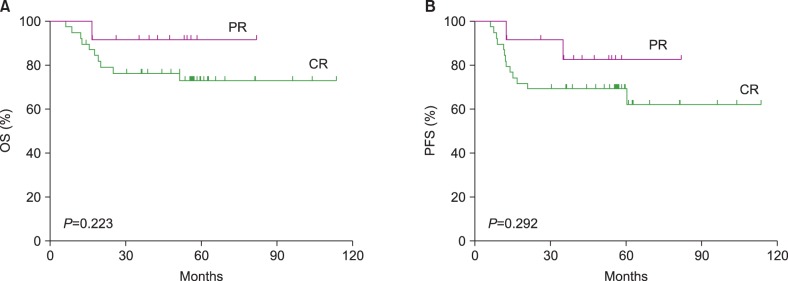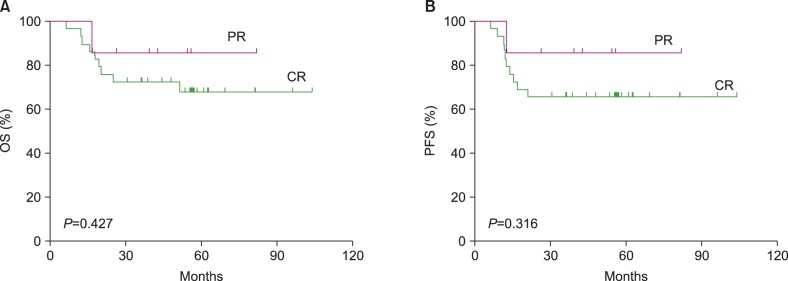Blood Res.
2014 Jun;49(2):107-114. 10.5045/br.2014.49.2.107.
R-CHOP chemoimmunotherapy followed by autologous transplantation for the treatment of diffuse large B-cell lymphoma
- Affiliations
-
- 1Department of Internal Medicine, Konkuk University Medical Center, Seoul, Korea. mlee@kuh.ac.kr
- 2Department of Internal Medicine, Seoul National University Hospital, Seoul, Korea.
- 3Department of Internal Medicine, Chonnam National University Hwasun Hospital, Hwasun, Korea.
- 4Department of Internal Medicine, Kosin University Gospel Hospital, Busan, Korea.
- 5Department of Medicine, Samsung Medical Center, Seoul, Korea.
- 6Department of Internal Medicine, the Catholic University of Korea, Seoul, Korea.
- 7Department of Internal Medicine, Hanyang University, Seoul, Korea.
- 8Department of Internal Medicine, Gachon University, Incheon, Korea.
- 9Department of Internal Medicine, Wonkwang University Hospital, Iksan, Korea.
- 10Department of Internal Medicine, National Cancer Center, Ilsan, Korea.
- 11Department of Internal Medicine, Daegu Fatima Hospital, Daegu, Korea.
- 12Department of Internal Medicine, Soonchunhyang University Hospital, Bucheon, Korea.
- 13Department of Internal Medicine, Yonsei University, Seoul, Korea.
- 14Department of Internal Medicine, Dankook University Hospital, Cheonan, Korea.
- KMID: 2172806
- DOI: http://doi.org/10.5045/br.2014.49.2.107
Abstract
- BACKGROUND
We investigated factors that influence outcomes in diffuse large B-cell lymphoma (DLBCL) patients treated with rituximab combined with the CHOP regimen (R-CHOP) followed by upfront autologous stem cell transplantation (Auto-SCT).
METHODS
We retrospectively evaluated survival differences between subgroups based on the age-adjusted International Prognostic Index (aaIPI) and revised-IPI (R-IPI) at diagnosis, disease status, and positron emission tomographic/computerized tomographic (PET/CT) status at transplantation in 51 CD20-positive DLBCL patients treated with R-CHOP followed by upfront Auto-SCT.
RESULTS
Patients had either stage I/II bulky disease (5.9%) or stage III/IV disease (94.1%). The median patient age at diagnosis was 47 years (range, 22-66 years); 53.3% and 26.7% had high-intermediate and high risks according to aaIPI, respectively. At the time of Auto-SCT, 72.5% and 27.5% experienced complete (CR) and partial remission (PR) after R-CHOP, respectively. The median time from diagnosis to Auto-SCT was 7.27 months (range, 3.4-13.4 months). The 5-year overall (OS) and progression-free survival (PFS) were 77.3% and 72.4%, respectively. The 5-year OS and PFS rates according to aaIPI, R-IPI, and PET/CT status did not differ between the subgroups. More importantly, the 5-year OS and PFS rates of the patients who achieved PR at the time of Auto-SCT were not inferior to those of the patients who achieved CR (P=0.223 and 0.292, respectively).
CONCLUSION
Survival was not influenced by the aaIPI and R-IPI at diagnosis, disease status, or PET/CT status at transplantation, suggesting that upfront Auto-SCT might overcome unfavorable outcomes attributed to PR after induction chemoimmunotherapy.
Keyword
MeSH Terms
Figure
Cited by 2 articles
-
Prediction of survival by applying current prognostic models in diffuse large B-cell lymphoma treated with R-CHOP followed by autologous transplantation
Hong Ghi Lee, Sung-Yong Kim, Inho Kim, Yeo-Kyeoung Kim, Jeong-A Kim, Yang Soo Kim, Ho Sup Lee, Jinny Park, Seok Jin Kim, Hyeok Shim, Hyeon Seok Eom, Byeong-Bae Park, Junglim Lee, Sung Kyu Park, June-Won Cheong, Keon Woo Park
Blood Res. 2015;50(3):160-166. doi: 10.5045/br.2015.50.3.160.Clinical characteristics and treatment outcomes of children and adolescents with aggressive mature B-cell lymphoma: a single-center analysis
Woojung Jeon, Young Kwon Koh, Sunghan Kang, Hyery Kim, Kyung-Nam Koh, Ho Joon Im
Blood Res. 2022;57(1):41-50. doi: 10.5045/br.2021.2021164.
Reference
-
1. Coiffier B, Thieblemont C, Van Den Neste E, et al. Long-term outcome of patients in the LNH-98.5 trial, the first randomized study comparing rituximab-CHOP to standard CHOP chemotherapy in DLBCL patients: a study by the Groupe d'Etudes des Lymphomes de l'Adulte. Blood. 2010; 116:2040–2045. PMID: 20548096.
Article2. Pfreundschuh M, Kuhnt E, Trumper L, et al. CHOP-like chemotherapy with or without rituximab in young patients with good-prognosis diffuse large-B-cell lymphoma: 6-year results of an open-label randomised study of the MabThera International Trial (MInT) Group. Lancet Oncol. 2011; 12:1013–1022. PMID: 21940214.
Article3. Ziepert M, Hasenclever D, Kuhnt E, et al. Standard International prognostic index remains a valid predictor of outcome for patients with aggressive CD20+ B-cell lymphoma in the rituximab era. J Clin Oncol. 2010; 28:2373–2380. PMID: 20385988.4. Vitolo U, Chiappella A, Brusamolino E, et al. A randomized multicenter phase III study for first line treatment of young patients with high risk (AAIPI 2-3) diffuse large B-cell lymphoma (DLBCL): Rituximab (R) plus dose-dense chemotherapy CHOP14/MEGA CHOP14 with or without intensified high-dose chemotherapy (HDT) and autologous stem cell transplantation (ASCT). Results of DLCL04 trial of Italian lymphoma foundation (FIL). Ann Oncol. 2011; 22(Suppl 4):iv106. (abst 72).5. Stiff PJ, Unger JM, Cook JR, et al. Autologous transplantation as consolidation for aggressive non-Hodgkin's lymphoma. N Engl J Med. 2013; 369:1681–1690. PMID: 24171516.
Article6. Le Gouill S, Milpied NJ, Lamy T, et al. First-line rituximab (R) high-dose therapy (R-HDT) versus R-CHOP14 for young adults with diffuse large B-cell lymphoma: Preliminary results of the GOELAMS 075 prospective multicenter randomized trial. J Clin Oncol. 2011; 29:abst 8003. ASCO Annual Meeting.
Article7. Cheson BD, Pfistner B, Juweid ME, et al. Revised response criteria for malignant lymphoma. J Clin Oncol. 2007; 25:579–586. PMID: 17242396.8. Juweid ME, Stroobants S, Hoekstra OS, et al. Use of positron emission tomography for response assessment of lymphoma: consensus of the Imaging Subcommittee of International Harmonization Project in Lymphoma. J Clin Oncol. 2007; 25:571–578. PMID: 17242397.
Article9. Haioun C, Lepage E, Gisselbrecht C, et al. Groupe d'Etude des Lymphomes de l'Adulte. Benefit of autologous bone marrow transplantation over sequential chemotherapy in poor-risk aggressive non-Hodgkin's lymphoma: updated results of the prospective study LNH87-2. J Clin Oncol. 1997; 15:1131–1137. PMID: 9060555.10. Haioun C, Lepage E, Gisselbrecht C, et al. Survival benefit of high-dose therapy in poor-risk aggressive non-Hodgkin's lymphoma: final analysis of the prospective LNH87-2 protocol-a groupe d'Etude des lymphomes de l'Adulte study. J Clin Oncol. 2000; 18:3025–3030. PMID: 10944137.
Article11. Cunningham D, Hawkes EA, Jack A, et al. Rituximab plus cyclophosphamide, doxorubicin, vincristine, and prednisolone in patients with newly diagnosed diffuse large B-cell non-Hodgkin lymphoma: a phase 3 comparison of dose intensification with 14-day versus 21-day cycles. Lancet. 2013; 381:1817–1826. PMID: 23615461.12. Philip T, Guglielmi C, Hagenbeek A, et al. Autologous bone marrow transplantation as compared with salvage chemotherapy in relapses of chemotherapy-sensitive non-Hodgkin's lymphoma. N Engl J Med. 1995; 333:1540–1545. PMID: 7477169.
Article13. Dilhuydy MS, Lamy T, Foussard C, et al. Front-line high-dose chemotherapy with rituximab showed excellent long-term survival in adults with aggressive large b-cell lymphoma: final results of a Phase II GOELAMS Study. Biol Blood Marrow Transplant. 2010; 16:672–677. PMID: 20045738.
Article14. Jabbour E, Peslin N, Arnaud P, et al. Prognostic value of the age-adjusted International Prognostic Index in chemosensitive recurrent or refractory non-Hodgkin's lymphomas treated with high-dose BEAM therapy and autologous stem cell transplantation. Leuk Lymphoma. 2005; 46:861–867. PMID: 16019530.
Article15. Sehn LH, Berry B, Chhanabhai M, et al. The revised International Prognostic Index (R-IPI) is a better predictor of outcome than the standard IPI for patients with diffuse large B-cell lymphoma treated with R-CHOP. Blood. 2007; 109:1857–1861. PMID: 17105812.
Article16. Dupuis J, Itti E, Rahmouni A, et al. Response assessment after an inductive CHOP or CHOP-like regimen with or without rituximab in 103 patients with diffuse large B-cell lymphoma: integrating 18fluorodeoxyglucose positron emission tomography to the International Workshop Criteria. Ann Oncol. 2009; 20:503–507. PMID: 19074215.
Article17. Moskowitz CH, Schoder H, Teruya-Feldstein J, et al. Risk-adapted dose-dense immunochemotherapy determined by interim FDG-PET in Advanced-stage diffuse large B-Cell lymphoma. J Clin Oncol. 2010; 28:1896–1903. PMID: 20212248.
Article
- Full Text Links
- Actions
-
Cited
- CITED
-
- Close
- Share
- Similar articles
-
- A Case of Epstein-Barr Virus-Positive Diffuse Large B-Cell Lymphoma Occurring in Thyroid Gland
- A Case of Primary Adrenal Diffuse Large B-cell Lymphoma Achieving Complete Remission with Rituximab-CHOP Chemotherapy
- Two Cases of Primary Esophageal Diffuse Large B Cell Lymphoma: Therapeutic Considerations and a Literature Review
- A Case of Mantle Cell Lymphoma Treated with Autologous Stem Cell Transplantation and Rituximab
- Primary Isolated Bone Marrow Diffuse Large B-cell Lymphoma with Hemolytic Anemia as the First Manifestation







